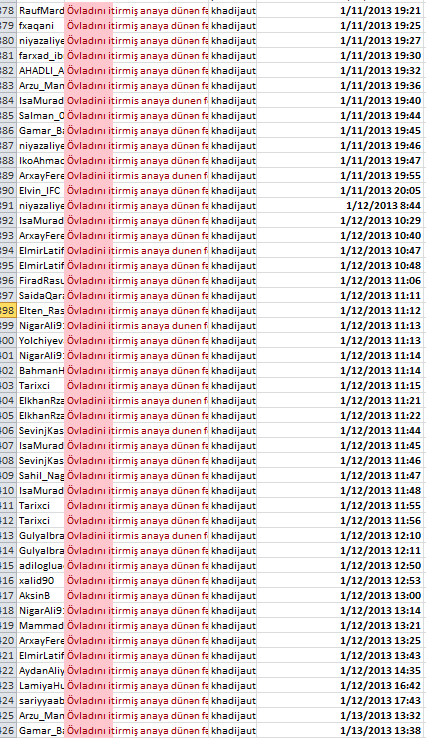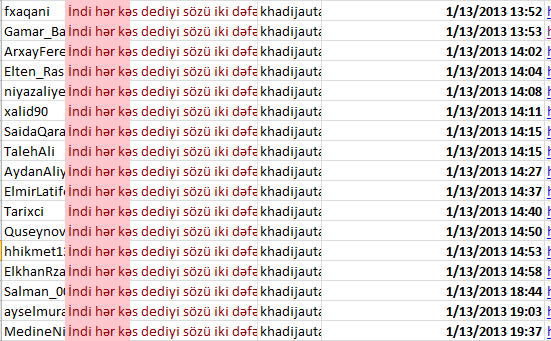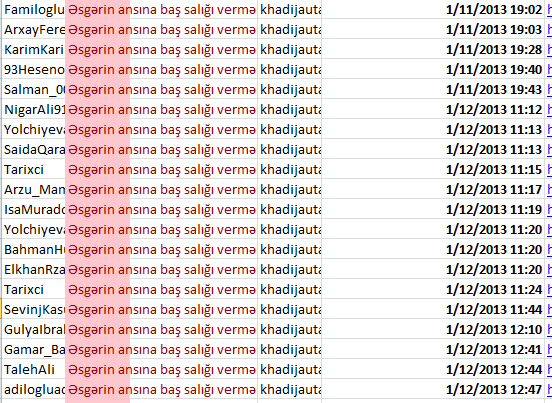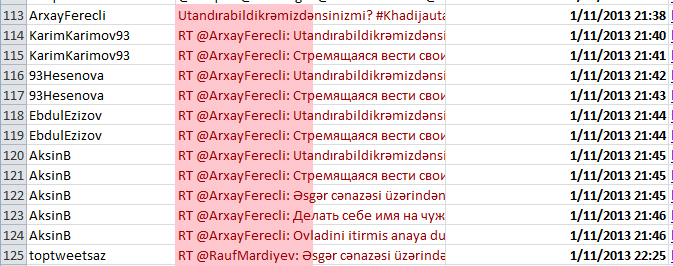In a reaction to #protestbaku, a number of Azerbaijani tweeters, especially those associated with the pro-government youth organization, began a Twitter campaign called #khadijautan. This translates to “shame on you Khadija.” Who is Khadija? She is a journalist with Radio Free Europe, known for her investigations of government corruption. (More on Khadija here). What was so shameful? She said “there is a need for mothers in this country who don’t bargain over their son’s dead bodies”[…].” More on this on Arzu Geybulla’s blog.
And those using the hashtag think that they succeeded: “With 22K people engaged, apx 200K impressions #KhadijaUtan campaign succeeded. #azerbaijan #protestBaku.”
When I was doing analysis of #protestbaku, I saw that a lot of the Twitter accounts using #khadijautan didn’t have a photo associated with them. That is sort of odd, right? Most people put a picture on their Twitter account.
[Here is a tl;dr:”Turns out… “successful” #khadijautan hashtag campaign was mainly executed by a cyber-zombie army of tweeters that had 1. No profile photo 2. No followers 3. Didn’t send any tweets before this campaign 4. They wrote the same message over and over again. Read this article only if you have basic knowledge of how twitter works and statistics.”]
Only 126 people used this hashtag but they tweeted using it 2198 times (that includes 557 retweets), so it was fairly easy to do analysis on this.
I looked a little closer to my social network analysis map and saw that those Tweeters without photos also tended to not have a lot of friends on Twitter. That’s also a little odd.
So I took a closer look. Link to the full report here.
To understand the following, let’s have a little refresher of high school statistics:
Average or mean = equal to the sum of the values divided by the number of values
Standard deviation = standard deviation shows how much variation or “dispersion” exists from the average (mean, or expected value). A low standard deviation indicates that the data points tend to be very close to the mean; high standard deviation indicates that the data points are spread out over a large range of values.
Mode = value that appears most often in a set of data
Here’s the distribution of followers and following for the people on this hashtag. You can see that the vast majority of those tweeting with #khadijautan don’t have very many other people that they follow or that follow them. The average number of people that #khadijautan Tweeters follow is 194, the mode is 122, standard deviation of 242. This means that even though some people follow a lot of people, most don’t.
The number of followers for one of these #khadijautan was on average 371, and the mode was 7, standard deviation was 562. Again, while some of these people have a lot of followers, most don’t.

And it looked like the users of the #khadijautan hashtag didn’t Tweet a lot.

The number of tweets for these people is average 5168, mode 45, standard deviation of 11715. Again, a lot of people that don’t tweet a lot were on this hashtag.
Then I sorted the Tweeters by the date that they joined Twitter. 14 of them joined Twitter in the last few days. That isn’t that many.
Here’s the distribution of when these people joined Twitter. As you can see, a lot of them joined recently.

This is unlike most hashtag analyses. It is odd.
—
But let’s look at the groups – this is essential to understanding what is going on.

Group 2, for example, are mostly people fighting AGAINST this hashtag (full disclosure, this includes myself).
Group 3 includes individuals that are regular Tweeters from the pro-government opposition group.
Groups 4 and 5 seems really strange to me. I’m not sure what’s going on there. They look like tweet aggregators.
So let’s talk about Group 1 then. The top tweeters are all in the middle, but look at all the accounts that don’t have profile pictures (the blue circles). (This is also the case for Group 3, but not as heavily.) There were 41 people in Group 1 and 34 people in Group 3. That isn’t a lot. They all follow each other. Not many people saw their hashtag.


—
Okay, the content of the Tweets. What were people saying on the #khadijautan hashtag?
(I’m going to summarize this, but you can download the whole file here if you want to look at it yourself.)
What ended up surprising me is that a lot of Tweets from these “no profile photo” accounts were basically the same statement over and over again. Not retweets, per se, but just the same statement.
For example, this: “Стремящаяся вести свои политические игры, пользуясь смертью невинного солдата #Khadijautan #aztwi” was said 27 times by 21 different “no profile photo” accounts. This seems really strange to me.
Or this tweet: “X.İsmayıl bazarlıq statusunun Samirə Qubadovaya aid olmadığını dedi. #KhadijaUtan kampaniyası məqsədinə çatmışdır! http://t.co/xCEM83kz” was said 18 times by many of the same people that were tweeting repeatedly in other cases too AND don’t have profile photos.
This strange behavior happened a LOT.
I think that it is fair to say that there is some sort of robot set up to do these tweets.
I welcome questions on this and encourage people to open the file and look for themselves.























